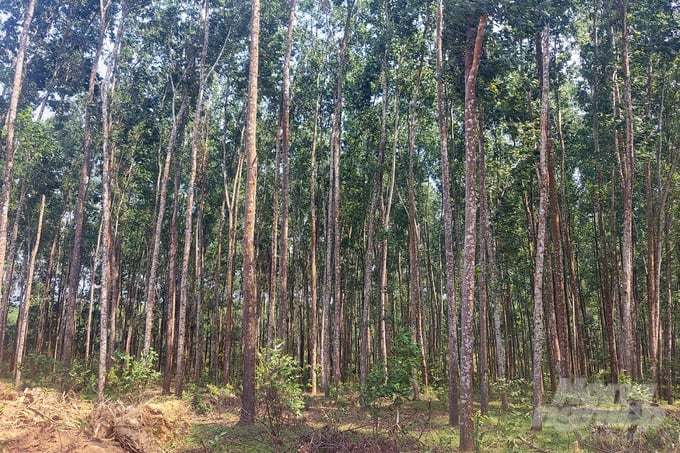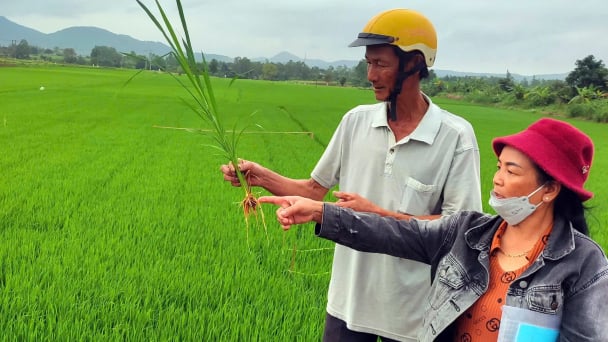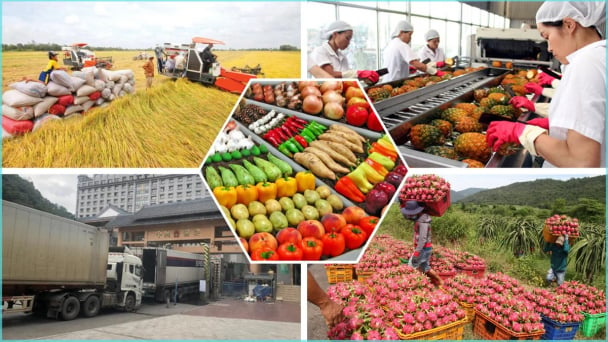June 4, 2025 | 17:39 GMT +7
June 4, 2025 | 17:39 GMT +7
Hotline: 0913.378.918
June 4, 2025 | 17:39 GMT +7
Hotline: 0913.378.918
Approximately ten years ago, prior to replanting, residents in Cam Thuy commune, Cam Lo district (Province of Quang Tri) burned the vegetation after harvesting wood from a planted forest. At the time, this was the situation of nearly all forest cultivators in Quang Tri.
It is explained that the burned vegetation will make it easier for machines to excavate pits for replanting, thereby reducing labor and costs. The accumulated quantity of ash would serve as a nutrient supplement for newly planted trees.
Nguyen Thi Lan, one of the households engaged in forest planting in the Thuy Dong Cooperative of the Cam Lo district, disclosed that she has possessed 0.5ha of forest land for acacia planting for the past two decades. After each cycle of exploitation (approximately 5 years), she burned vegetation in preparation for a new plantation. The yield of her acacia planting in each cycle was between 120 and 130 tons per hectare.
But in the most recent acacia growing cycle, Lan stopped burning vegetation, hired a stump scoop to remove tree trunks, and tilled the soil in preparation for replanting.

Most people in Cam Thuy no longer burn vegetation after harvesting, so the growth rate of the forest is righteous, the yield is always 15 - 25% higher than that of burning vegetation. Photo: Vo Dung.
The director of Thuy Dong Agricultural Services Cooperative, Nguyen Van Luc, stated that the practice of dense forest plantation is the only alternative to burning vegetation.
However, in addition to the problem of causing air pollution and even forest fires, the burning of vegetation after harvesting provides few economic benefits and even long-term damages. Numerous households have not yet accounted for this afforestation-related issue.
However, in addition to the problem of causing air pollution and even forest fires, the burning of vegetation after harvesting provides few economic benefits and even long-term damages. Numerous households have not yet accounted for this afforestation-related issue.
Formerly a senior forest cultivator in the Cam Thuy commune, Mr. Le Tai Hanh, a member of the Thuy Tay Cooperative, was well aware of the negative consequences of burning vegetation after harvest.
"Burning vegetation not only causes smog, environmental pollution, and the potential danger of forest fires, but it also disrupts soil structure, destroys biological systems in the earth, and drastically diminishes the productivity of planted forests".
"If you burn the vegetation prior to replanting, the acacia tree will only grow rapidly for the first one to two years. After that, roughly a third of the acacia trees will perish on their own compared to the time of planting. By burning vegetation, the yield typically decreases by 20 tons per 5- to 5.5-year cycle. This is a proven fact," he said.

The stumps and vegetation of the previous cycle decompose, forming a useful organic source for forest trees to grow and a "roof" for organisms in the soil. Photo: Vo Dung.
Mr. Nguyen Van Luc, Director of Thuy Dong Agricultural Service Cooperative, stated that, from the perspective of planting and care techniques, burning the vegetation after harvesting also causes the acacia seeds to burst and develop readily. Acacia trees grown from the seedlings of acacia trees have a high yield and high-quality timber, but they have high vitality and compete with newly planted acacia trees for food and light, thereby increasing the density of the forest. Since then, newly planted acacia forests have not produced wood as anticipated.
Currently, the Cam Thuy commune (Cam Lo district, Quang Tri) has 625ha of acacia plantations. The majority of these vast timber forests are managed by the Thuy Dong Agricultural Service Cooperative, which has been awarded a certificate of sustainable forest management (FSC) for 25ha of forest.

Retaining plants helps to create organic sources on the ground, retain water, keep the flora in the ground and create a long-term food source for forest trees. Photo: Vo Dung.
My family has not torched vegetation after forest exploitation for more than a decade, as this is a requirement for FSC-certified forests. Large timber plantations are frequently irregularly planted, so it is not necessary to burn vegetation, but the machinery is still useful for digging holes. In addition, I conducted a comparison and demonstrated that avoiding the burning of vegetation increases the productivity of planted forests by 15 to 25 percent, as stated by Mr. Hanh.
Mr. Hanh led us to an FSC-certified forest garden that was ten years old and located in the Central region, where temperatures reached nearly 40 degrees Celsius. Under the forest's canopy, the sun's rays and temperature diminished. The forest canopy has closed, and tall trees indicate that Mr. Hanh's family has completed a successful acacia cycle.
Mr. Hanh analyzed this forest by removing a handful of damp forest soil from beneath the vegetation and comparing it to other forests that fire the harvested vegetation. The relative humidity is higher, and worms, insects, and native flora have been observed approximately 4 - 5 cm underground. The trunks harvested during the previous cycle were neither burnt nor removed; they have decomposed significantly. It contains numerous endemic microorganisms.

Nguyen Tai Hanh (member of Thuy Tay Cooperative, Cam Thuy, Cam Lo, Quang Tri) is expected to bring in over 400 million VND/ha after 10 years. Photo: Vo Dung.
Going deeper into planted forests without burning the vegetation provides a milder sensation, and the trees are sturdier, more uniform, more productive, and considerably more cost-effective than the previous practice of burning vegetation.
Currently, there are numerous cooperatives for sustainable afforestation in Quang Tri. At the majority of these cooperatives, forest producers cultivate large timber forests in pursuit of FSC certification and in partnership with a number of businesses to ensure stable output. Obviously, as large timber plantations move toward FSC certification, people will be required to abandon the practice of burning vegetation following harvesting.
Mr. Nguyen Van Luc, Director of Thuy Dong Agricultural Service Cooperative, stated that the transition from small timber forests to large timber forests and FSC forests is essential for the sustainability and efficacy of afforestation. Because this is a requirement for the forest to be granted FSC certification, the incidence of burning vegetation after harvesting will also decrease naturally at that time. When a forest receives FSC certification, new timber materials have the opportunity to access the global market, thereby increasing the value of planted forests.
Translated by Linh Linh

(VAN) At Thaifex Anuga Asia 2025, Asia’s leading food and beverage trade show, more than 170 Vietnamese enterprises are participating, with Vinamilk having been a consistent presence for nearly 20 years.

(VAN) On June 3, the Institute of Agricultural Environment organized a workshop titled 'Supporting greenhouse gas inventories in agriculture: Enhancing technical and governance insights for rice production in Vietnam'.

(VAN) In the first 5 months, the export turnover of agricultural, forestry, and fishery products rise significantly, thanks to a relatively stable domestic production and export market.

(VAN) Deposit Return System (DRS) created a natural cycle of responsibility, reinforced by social norms and practical necessity. Materials had value and returning them was second nature.

(VAN) According to the Norwegian Ambassador to Vietnam Hilde Solbakken, sorting waste at source and individual responsibility are key factors for sustainable waste management.

(VAN) On June 5, in Can Tho City, the Vietnam Rice Industry Association (VIETRISA) and Trung An Company will hold a ceremony to export the first shipment of 'Green and Low-Emission Vietnam Rice' to Japan.

(VAN) Minister Do Duc Duy believes this event will mark the start of a new chapter in deeper cooperation between Vietnam’s agricultural sector and the state of Iowa.